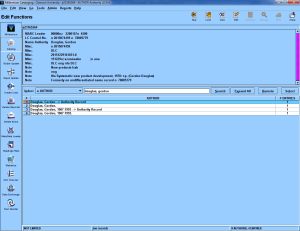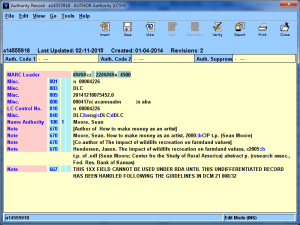In our quarterly update (Notification) service, we often have name authority records that are spun off of undifferentiated name records we have in our catalog. These records appear in the NAME.NEW and the NAME.CHG files.
Undifferentiated name records were allowed under AACR2: if a cataloger found a conflict between two writers but could not find out information about his writer that did not fall within the very narrow guidelines under AACR2 (a “fuller form of name” qualifier, or a birth/death date), they either added that author’s name to an already established record or created a new one. These records are characterized by multiple 670s with square brackets around a citation such as “[Author of How to be a cataloger and stay sane].”
Example of undifferentiated name record; note the 670s with square brackets. Note also the 667 in all caps. Most undifferentiated name records now have this note.
These are now spun off because the RDA standards do not allow undifferentiated name authority records. They do allow a wider range of ways to make a name unique, such as a free text qualifier, like (Writer on cataloging).
Backstage handles these by sending us any and all records spun off of an undifferentiated name record; this makes sense because they don’t necessarily know which author we have in our catalog.
It is helpful to look at these name authorities one by one and decide whether they need to remain in the catalog.
You will be given a spreadsheet with a list of names and their accompanying 667 notes saying “Formerly on undifferentiated record <LC record no>” or “Last identity on record <LC record number>.”
- With the spreadsheet in hand, do an author search in Millenium for the name on your list. EXAMPLE: Douglas, Gordon
- Look at the authority record for Douglas, Gordon. It’s a “formerly on” record.

3. Is the title for the resource in the authority record’s 670 the same as the one in our catalog, or in a subject close to what we have? If so, we need to keep the record and make sure that bib record headings match the authority record.
4. To be extra-thorough, do an ARN (z) search in Millennium for the undifferentiated name record (from the 667 note). If you get a result saying “<LCCN should be here>,” then you can be certain that the old undifferentiated name record is not in the catalog.
5. Mark your spreadsheet with a fill color meaning that the work on the name is complete, and put a note, “Kept” in the Notes Field. If you have to delete a record, put “Delete” in the spreadsheet and put the LCCN in the Adds and Deletes spreadsheet.
The example above is the simplest kind, and we should always hope that they are all like this. But they’re not.
Consider the following things as well as you examine authority and bib records;
- The name authority turns out to be needed because a bib record with another heading is present. It pays to look at all the names you retrieve on your author search. It’s also one reason why doing a general author search for the name without qualifiers or dates is a good thing to do.
- Sometimes the LC control number of the old undifferentiated record finds its way into a new spun-off record as an invalid LCCN, and sometimes those records overlay when loaded into Millennium. ***Make sure that you do not delete a new spun-off record that has overlaid an old undifferentiated record.
- Sometimes the name authority sent us by Backstage is not the correct one, based on what we have in our catalog and what is in the 670 note. It is fine to delete an unneeded authority record; you just need to put it in the Adds and Deletes Spreadsheet.
- The consistency of how records were created or spun off of undifferentiated name records is a little spotty; LC was doing many of them, but NACO libraries got into it too, based on whether or not they had to deal with an author on a particular undifferentiated name record. So there will be some authors on an undifferentiated record that do not have their own records yet. As all of the authors on a record have new authority records completed for them, the original undifferentiated record will be deleted.
- Doing this successfully requires thinking not only about the form of name in the existing authority record (on the spreadsheet) but also other forms of name like it in Millennium.
- When in doubt, don’t delete an authority record. Let Lisa take a look at it.

